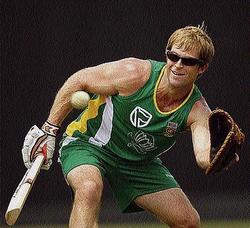
South African fielding coach Jonty Rhodes trains his side near Port of Spain, Trinidad. - Reuters FRIGATE BAY, St. Kitts (Reuters):
COMPARED TO batting or bowling, fielding would seem to be cricket's most simple discipline.
Latch on to the ball with your hands and hurl it towards your chosen target. Simple, surely.
Surely not, according to Jonty Rhodes, a livewire fielder in his playing days and now South Africa's fielding coach.
"I've been trying to work really hard on body position," Rhodes said. "You can have great hands, but if you can't get to the ball, the hands aren't going to help. So, a lot of it is footwork and getting the body into the right position. Not only to catchthe ball, but also to throw the ball. The key is anticipation, because first of all you don't want the ball to get past you."
Teams in Group A of the World Cup were presented with an unusual challenge in the shape of the match venue, Warner Park in Basseterre, St. Kitts, which is one of the smallest grounds in international cricket.
"The guys at third man and fine leg are vital on this ground," Rhodes said. "Half a hit down there, and it goes for four. If a batsman squeezes out a yorker, it's likely to go for four."
South Africa's fielding has long been respected and former players like Colin Bland and Peter Kirsten were renowned for their predatory prowess in the covers.
New level
But Rhodes took the art to a new level when he burst on to the scene following South Africa's return from international isolation in the early 1990s.
He will always be remembered for his diving run out of Pakistan's Inzamam-ul-Haq during the 1992 World Cup.
Fielding rather than batting, Rhodes said, was his ticket to the tournament.
"I went to the 1992 World Cup because I could field," he said. "There must have been far better players than me to choose from, but (then South African captain) Kepler Wessels insisted that there are big fields in Australia and you needed young legs. You can be an all-rounder if you save runs in the field."
Rhodes held the current generation of South Africa's sharpest fielders in high regard.
"We have guys like Herschelle (Gibbs), A.B. (de Villiers) and Ashwell (Prince) who are awesome in the inner ring," Rhodes said. "Batsmen have to find a very small gap to get past them."
Fielding sessions
Shaun Pollock, meanwhile, patrols the outfield with special vigilance.
"'Polly' is an old man in the team, but his movement is great," Rhodes said. "He gets his feet and body position right."
Rhodes's approach to fielding drills emphasised quality rather than quantity.
"Most of the skills in cricket concern batting and bowling, and if you work on those forthree hours and then have to do a 40-minute fielding session it makes for a long day," he said.
"Sometimes I work with the guys for just five minutes. We don't practise for the sake of practising. If I see something wrong we'll work on it. When the guys leave their hands are stinging, but then it's over."

